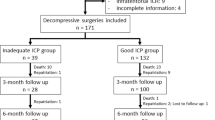Summary
In search of guidelines for the management of traumatic intracerebral haematomas (TICHs) with slight mass effects on computed tomography (CT) scans, the author reviewed the records of 29 patients who did not undergo surgery and 11 patients who did.
It is found that patients with a TICH volume of less than 15 ml, a midline shift of less than 5 mm, an open perimesencephalic cistern on CT scans, a Glasgow Coma Scale (GCS) score of 12 or more, and an absence of lateralizing signs may be treated conservatively and expected to make a good recovery. On the other hand, with zero mortality and satisfactory outcomes, the patients undergoing early surgery tended to have a TICH volume of more than 15 ml, a midline shift of more than 5 mm, an obliterated perimesencephalic cistern on CT scans, a GCS score of less than 12, and the presence of lateralizing signs. However, the position of such features as the criteria of early operation for a TICH is weakened by the retrospective nature of this study because some surgical patients, free of lateralizing signs in particular, might have managed to do well without craniotomy.
Similar content being viewed by others
References
Alexander E, Ball MR, Laster DW (1987) Subtemporal decompression: radiological observations and current surgical experience. Br J Neurosurg 1: 427–433
Brown FD, Mullan S, Duda EE (1978) Delayed traumatic intracerebral hematomas. Report of three cases. J Neurosurg 48: 1019–1022
Bullock R, Golek J, Blake G (1989) Traumatic intracerebral hematoma — which patients should undergo surgical evacuation? CT scan features and ICP monitoring as a basis for decision making. Surg Neurol 32: 181–187
Chan KH, Mann KS, Yue CP, Fan YW, Cheung M (1990) The significance of skull fracture in acute traumatic intracranial hematomas in adolescents: a prospective study. J Neurosurg 72: 189–194
Chen TY, Wong CW, Chang CN, Lui TN, Cheng WC, Tsai MD, Lin TK (1993) The expectant treatment of “asymptomatic” supratentorial epidural hematomas. Neurosurgery 32: 176–179
Diaz FG, Yock DH, Larson D, Rockswold GL (1979) Early diagnosis of delayed posttraumatic intracerebral hematomas. J Neurosurg 50: 217–223
Galbraith S, Teasdale G (1981) Predicting the need for operation in the patient with an occult traumatic intracranial hematoma. J Neurosurg 55: 75–81
Gudeman SK, Kishore PRS, Miller JD, Girevendulis AK, Lipper MH, Becker DP (1979) The genesis and significance of delayed traumatic intracerebral hematoma. Neurosurgery 5: 309–313
Illingworth G, Jennett WB (1965) The shocked head injury. Lancet 2: 511–514
Jennett B (1974) Epilepsy and acute traumatic intracranial haematoma. J Neurol Neurosurg Psychiatry 38: 378–381
Knuckey NW, Gelbard ST, Epstein MH (1989) The management of “asymptomatic” epidural hematomas. A prospective study. J Neurosurg 70: 392–396
Lee ST, Lui TN (1991) Delayed intracranial haemorrhage in patients with multiple trauma and shock-related hypotension. Acta Neurochir (Wien) 113: 121–124
Lobato RD, Rivas JJ, Gomez PA, Castaneda M, Canizal JM, Sarabia R, Cabrera A, Munoz MJ (1991) Head-injured patients who talk and deteriorate into coma. Analysis of 211 cases studied with computerized tomography. J Neurosurg 75: 256–261
Marshall LF, Marshall SB, Klauber MR, Clark MVB, Eisenberg HM, Jane JA, Luerssen TG, Marmarou A, Foulkes MA (1991) A new classisfication of head injury based on computerized tomography. J Neurosurg 75: S14–20
Marshall LF, Toole BM, Bowers SA (1983) The national traumatic coma data bank. Part 2: Patients who talk and deteriorate: implications for treatment. J Neurosurg 59: 285–288
Miller JD (1986) Minor, moderate and severe head injury. Neurosurg Rev 9: 135–139
Miller JD (1992) Evaluation and treatment of head injury in adults. Neurosurg Quart 2: 28–43
Miller JD, Butterworth JF, Gudeman SK, Faulkner JE, Choi SC, Selhorst JB, Harbison JW, Lutz HA, Young HF, Becker DP (1981) Further experience in the management of severe head injury. J Neurosurg 54: 289–299
Pang D, Horton JA, Herron JM, Wilgerber JE, Vries JK (1983) Nonsurgical management of extradural hematomas in children. J Neurosurg 59: 958–971
Petersen OF, Espersen JO (1984) Extradural hematomas: measurement of size by volume summation on CT scanning. Neuroradiology 26: 285–292
Servadei F, Giucci G, Morichetti A, Pagano F, Burzi M, Staffa G, Piazza G, Taggi F (1988) Skull fracture as a factor of increased risk in minor head injuries. Indication for a broader use of cerebral computed tomography scanning. Surg Neurol 30: 364–369
Soloniuk D, Pitts LH, Lovely M, Bartkowski H (1986) Traumatic intracerebral hematomas: timing of appearance and indications for operative removal. J Trauma 26: 787–794
Wong CW (1994) The CT criteria for conservative treatment — but under close clinical observation — of posterior fossa epidural haematomas. Acta Neurochir (Wien) 126: 124–127
Young HA, Gleave JRW, Schmidek HH, Gregory S (1984) Delayed traumatic intracerebral hematoma: report of 15 cases operatively treated. Neurosurgery 14: 22–25
Author information
Authors and Affiliations
Rights and permissions
About this article
Cite this article
Wong, C.W. CT and clinical criteria for conservative treatment of supratentorial traumatic intracerebral haematomas. Acta neurochir 135, 131–135 (1995). https://doi.org/10.1007/BF02187756
Issue Date:
DOI: https://doi.org/10.1007/BF02187756




